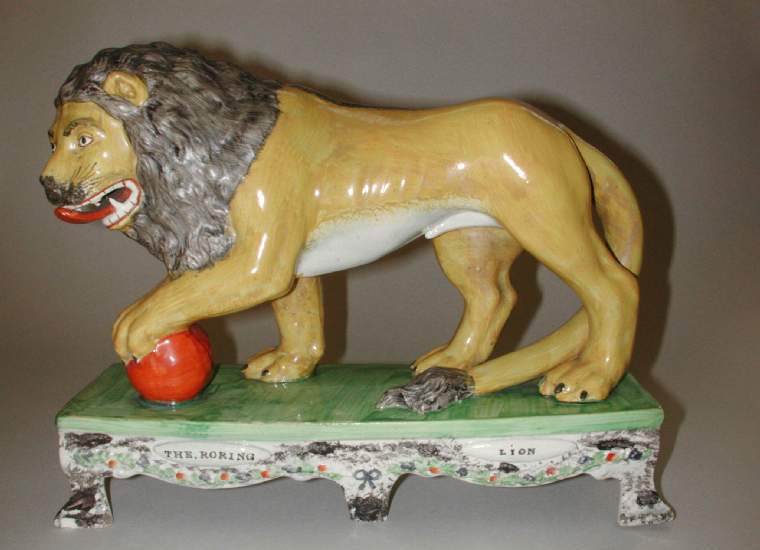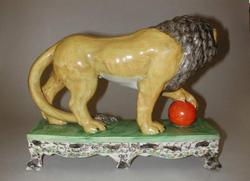Current Location: Gallery 27 (Glaisher)
Titles
The Roring Lion
Maker(s)
Unidentified Pottery
(Probably)
Entities
Categories
Description
Earthenware figure, moulded with modelled additions, lead glazed and painted with polychrome enamels.
Large animal figure of a lion, with left foot raised on a ball and open mouth with protruding tongue, standing on a rectangular table base. The tail tip and mane are modeled to suggest thick fur and coloured grey brown. The lion’s genitals are shown and the underbelly is left unpainted. The rest of the body is mustard yellow, with visible brush marks indicating the pelt. The tongue is red and the mouth and eyes outlined in red. The ball, or globe, is also red. The figure is fully shaped in the round and decorated all over. The base is a grass green rectangular plinth supported on a grey sponged table base which has six feet, a moulded polychrome swag frieze and on the front two raised ovals with the impressed inscription ‘THE.RORING’ and ‘LION’. The underside is recessed and glazed.
Notes
History note: Bought from Mr Wordingham, Cambridge dealer, on 3 April 1921, by Dr J.W.L. Glaisher, FRS, Trinity College, Cambridge. £15 paid for this and a companion piece ‘The Death of Munro’. Both pieces said to have come from Cromer Hall.
Legal notes
Dr J.W.L. Glaisher Bequest, 1928
Measurements and weight
Depth: 10.2 cm
Height: 25.3 cm
Width: 33.5 cm
Acquisition and important dates
Method of acquisition: Bequeathed
(1928-12-07)
by
Glaisher, J. W. L., Dr
Dating
19th Century, second quarter
Production date:
circa
AD 1830
Note
Pearlware figure groups were popular from around 1810, although the earliest examples date from about 1790 They were produced by many small potteries and very few are marked. Classical or literary subjects might be copied from more expensive porcelain examples, but scenes from everyday life and topical events were also increasingly popular. Early figure groups are often complex, with modelled and moulded parts and applied decoration; the backs, though flat, are decorated. But by c.1835 three-part press-moulding had largely taken over, enabling faster and cheaper production for a growing market.
The lion is based on a pair which stand at the entrance of the Loggia dei Lanzi in Florence, one a 2nd Century Roman lion and its companion sculpted by Flaminio Vacca in 1594. They were moved from the gardens of the Villa Medici in Rome to Florence in 1789. Small scale reproductions in stone, marble, plaster and bronze were widely circulated and may have been used as a source for earthenware lions, often made in pairs to be placed at opposite ends of a dresser or bookcase.
This is one of several Staffordshire lions in the Fitzwilliam collection. The size, base, palette and style of moulding are so similar to a tiger figure in the collection, ‘The Death of Munro’ (C.967-1928), that they are probably by the same maker and perhaps companion pieces. In 1921, Dr Glaisher wrote: ‘these two pieces were in such wonderful condition that I felt obliged to buy them’. The table-base helps to fix the date. Standing on four or six short legs, table-base groups were made from c.1825-35 and have in the past been attributed to Obadaiah Sherratt, of Burslem; however they were probably made by a number of Staffordshire figure makers.
School or Style
Neoclassical
People, subjects and objects depicted
Components of the work
Decoration
composed of
enamels
lead-glaze
Parts
Materials used in production
Earthenware
Techniques used in production
Moulding
: Earthenware, moulded and modelled, lead glazed and painted with enamels.
Inscription or legends present
- Text: No.4099. Staffordshire lion inscribed in front ‘The Roring Lion’ b. in Cambridge [another word] 1921 (said to have come from Cromer Hall).
- Location: Underside of base
- Method of creation: Rectangular paper label handwritten in black ink
- Type: Label
References and bibliographic entries
Identification numbers
Accession number: C.968-1928
Primary reference Number: 76468
Old object number: 4099
Stable URI
Audit data
Created: Saturday 6 August 2011
Updated: Monday 29 April 2024
Last processed: Tuesday 15 July 2025
Associated departments & institutions
Owner or interested party:
The Fitzwilliam Museum
Associated department:
Applied Arts





